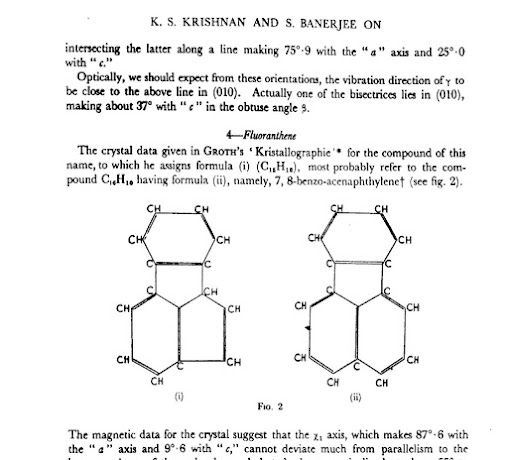On this day, 95
years ago, the great Physicist Sir CV Raman discovered what is now known as Raman
scattering, for which he later became the first Asian to win the Nobel Prize in
Physics. .. .. honestly, I understand
nothing of this pic and have not heard of this great personality earlier (not CV
Raman !!)
Sir
Chandrasekhara Venkata Raman FRS (7.11.1988 to 21.11.1970) was a physicist known for his work in the field of
light scattering. Using a spectrograph that he developed, he and his student K. S. Krishnan discovered
that when light traverses a transparent material, the deflected light changes
its wavelength and frequency. This phenomenon, a
hitherto unknown type of scattering of light, which they called "modified
scattering" was subsequently termed the Raman effect or Raman scattering. Sir Raman received the 1930 Nobel Prize in
Physics for the discovery and was the first Asian to receive a Nobel Prize in
any branch of science.
Raman
scattering or the Raman effect is the inelastic scattering of photons by
matter, meaning that there is both an exchange of energy and a change in the
light's direction. Typically this effect involves vibrational energy being
gained by a molecule as incident photons from a visible laser are shifted to
lower energy. This is called normal Stokes Raman scattering. The effect is
exploited by chemists and physicists to gain information about materials for a
variety of purposes by performing various forms of Raman spectroscopy.
Light
has a certain probability of being scattered by a material. When photons are
scattered, most of them are elastically scattered, such that the scattered
photons have the same energy (frequency, wavelength and color) as the incident
photons but different direction.
The Raman effect is named
after the great Indian scientist C. V.
Raman, who discovered it in 1928 with assistance from his student K. S.
Krishnan. Raman was awarded the 1930 Nobel Prize in Physics for his discovery
of Raman scattering. The effect had been predicted theoretically by Adolf
Smekal in 1923.
For sure we read about Sir CV Raman in school text books but did
we about Sir Kariamanikkam Srinivasa Krishnan who too was born in a Vaishnavaite
family in Watrap, Tamil nadu.
KS
Krishnan (4.12.1898 – 14.6.1961) was a great Physicis who was co-discoverer of Raman scattering, for which
his mentor C. V. Raman was awarded the 1930 Nobel Prize in Physics. His father
was a farmer-scholar deeply versed in Tamil literature. He had his early
education in Hindu Higher Secondary school, in Watrap, after which he attended
the American College in Madurai and the Madras Christian College. After gaining
his degree in Physics he became a demonstrator in chemistry.
In
1920, Krishnan went to work with C.V. Raman at the Indian Association for the
Cultivation of Science, Calcutta. There he engaged himself in experimental
study of the scattering of light in a large number of liquids and its
theoretical interpretations. He played a significant role in the discovery of
the Raman scattering. In 1928 he moved to the Dacca University (now in
Bangladesh) as the Reader in the physics department where he studied magnetic
properties of crystals in relation to their structure. Krishnan, along with
other rising scientists such as Santilal Banerjee, B.C. Guha, and Asutosh
Mukherjee developed an elegant and precise experimental technique to measure
the magnetic anisotropy of diamagnetic and paramagnetic crystals. Their
findings were published by the Royal Society of London in 1933 under the title,
Investigations on Magne-Crystallic Action.
In
1933 he returned to Kolkata to take up the post of Mahendralal Sircar Professor
of Physics in the Indian Association for the Cultivation of Science where he
continued to collaborate fruitfully with Banerjee to elaborate on the magnetic
properties of crystals in relation to their structure. Krishnan was elected as Fellow of the Royal
Society (FRS) in 1940.
His
Royal Society candidature certificate in 1935 read: "Distinguished for his
investigations in molecular optics and in magne-crystalline action:collaborated
with Sir C.V. Raman in extensive theoretical and experimental studies on light
scattering, molecular optics and in the discovery of the Raman Effect (1928).
More recently has been publishing many valuable investigations (Phil Trans
Royal Society and elsewhere) on the significance of magnetic anisotropy in
relation to crystal architecture and thermo-magnetic behaviour at the lowest
temperatures. Has published important work on pleochroism in crystals and its
relation to photo-dissociation. Leader of an active school of research in
Calcutta.
In
1942, he moved to Allahabad University as Professor and Head of the Department
of Physics where he took up the physics of solids, in particular of metals. He was knighted in the 1946 Birthday Honours List and awarded
the Padma Bhushan by the Government of India in 1954. He was the first
recipient of the prestigious Bhatnagar Award in 1958. On 4 January 1947 K. S.
Krishnan was appointed first director of National Physical Laboratory India.
This was one of the earliest national laboratories set up under the Council of
Scientific and Industrial Research.
Inspirational ! - should
we not be reading the life history of such great people instead of Babar,
Aurangazeb, slave dynasty, Robert Clive Clement Atlee .. .. .. and you know who
!!
28.2.2023



Very true we should read and know more about our son's of Bharat mata and their contribution Very informative post
ReplyDelete